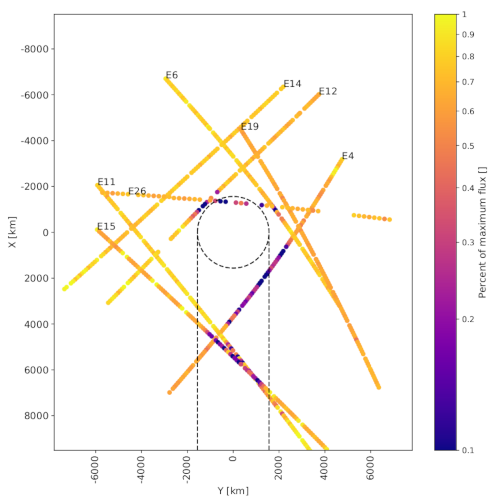- 1ESA, ESTEC, Noordwijk, Netherlands (hans.huybrighs@esa.int)
- 2KTH, Royal Institute of Technology, Stockholm, Sweden
- 3MPS, Max Planck Institute for Solar System Research, Göttingen, Germany
- 4Leiden University, Leiden, the Netherlands
- 5IRF, Swedish Institute of Space Physics, Kiruna, Sweden
The flux of energetic protons (80 keV-1.04 MeV) near the Galilean moons was measured by the Energetic Particle Detector (EPD) on the Galileo mission (1995 - 2003). Near Galilean moons (such as Io and Europa) depletions of the energetic ion flux, of several orders of magnitude, were observed (see Figure 1).
Such energetic ion depletions can be caused by the precipitation of these particles onto the moon’s surface or charge exchange with the neutral atmosphere. In addition, a magnetic field gradient can restrict access of the ions to certain regions, creating a “forbidden region.” To interpret the depletion features in the EPD data, a Monte Carlo particle tracing code has been developed. The expected flux of the energetic ions is simulated under different scenarios including those with and without an atmosphere, plume or inhomogeneous electromagnetic field. By comparing the simulated distribution to the EPD data, the cause of the depletion features can be investigated.
We identify the following causes of energetic proton depletions near Europa:
- Depletions are consistent with plumes during the flybys E12 and E26. These plumes coincide with the source location of Jia et al., 2018 and Arnold et al., 2019.
- Depletions are consistent with atmospheric charge exchange during the flyby E26
- Depletions coincide with Europa’s Alfvén wing during the flybys E17 and E25A. The Alfvén wings are two cylindrical regions extending to the north and south of Europa in which the low-energy plasma and the magnetic field are modified compared to the upstream conditions.
Furthermore, we investigate the effect of varying the atmospheric properties (scale height, density, presence of a sputtered component) and plume properties (density, location) on the depletions.

Figure 1: Normalized flux of H+ (220 to 550 keV) during the Galileo flybys of Europa. Depletions shown as darker colors.
How to cite: Huybrighs, H., Blöcker, A., Roussos, E., van Buchem, C., Krupp, N., Futaana, Y., Barabash, S., Holmberg, M., and Witasse, O.: Energetic proton depletions near Europa: plumes, atmospheric charge exchange and Alfvén wings, Europlanet Science Congress 2020, online, 21 Sep–9 Oct 2020, EPSC2020-266, https://doi.org/10.5194/epsc2020-266, 2020.

